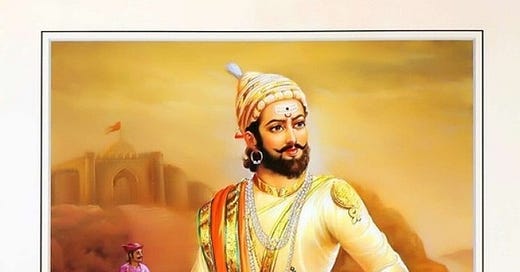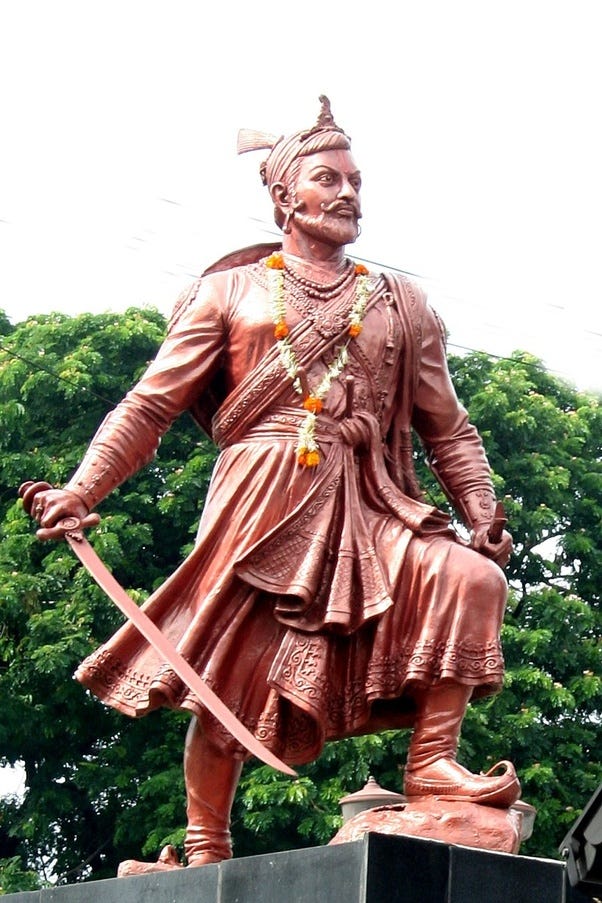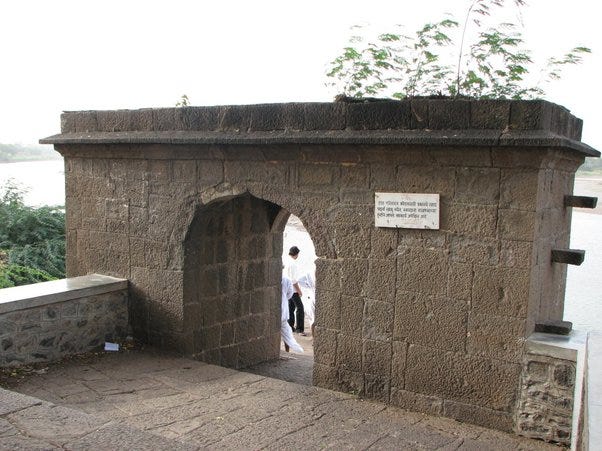It was the long war with the Marathas, after Shivaji Maharaj’s passing away in 1680, till Aurangzeb’s death in 1707, that effectively laid the foundation for the demise of the Mughal Empire. What is to be noted, is that this was the period where the Maratha Empire itself was caught up in bitter internal struggles for the throne, but they still managed to check the Mughal advance.
Post Shivaji Maharaj’s passing away, his son Sambhaji took over the throne in 1681 and Aurangzeb sensing a chance, attacked the Maratha forts,laying siege to them. Making Aurangabad his capital, he launched an attack on the Maratha forts, with a massive 500,000 army. However the Marathas inspite of being outnumbered, fought back, as in the siege of Ramsej Fort near Nashik, which the Mughals managed to conquer with great difficulty after 7 years.
In 1683, Aurangzeb moved further to Ahmednagar, putting his sons Shah Alam and Azam Shah in charge of two units that would attack South Konkan and the Khandesh region, through a pincer attack. Though Shah Alam, managed to enter Goa and move towards the North Konkan, the Marathas continued to harass the Mughals with guerilla attacks, disrupting his supply chains, reducing the forces to starvation. Another attempt to capture Raigad failed, when Hambirao Mohite, the Maratha commander, succesfully repulsed the Mughal forces.
In the meantime Aurangzeb conquered both Bijapur and Golconda, ending the Sultanates there. Sambhaji again mounted an assault on him, he was however betrayed by Ganoji Shirke, one of his brothers in law, who gave away his location to Muqarrab Khan. Sambhaji was captured on February 1689 and tortured in the most gruesome manner to force him to accept Islam. His skin was peeled off with a Bagh Nakh, he was blinded, branded with hot irons, but he preferred to accept death rather than convert.
Finally Sambhaji was executed, at Tuljapur, and his body cut into pieces was thrown into the Bhima River. Aurangzeb hoped, that Sambhaji’s brutal execution would crush the Maratha spirit, however the opposite happened, as it actually spurred them on to resist even more intensely.
Sambhaji’s younger brother Rajaram was now the Chhatrpathi, and in March 1690, the Marathas under Santaji Ghorpade, led a furious assault on the Mughals, massacring them en masse. Aurangzeb escaped the carnage, but his private bodyguard and many members of his force were killed. Though Raigad was captured by treachery of Suryaji Pisal, the Marathas put up a stout defence for Panhala fort.
Rajaram managed to escape towards South, with the help of Khando Ballal, as he took refuge in Gingee. By late 1691, the Marathas came up with a counter strategy as per which Santaji Ghorpade and Dhanaji Jadhav, would attack the Mughals in the East, while others would engage them in Southern Maharashtra, Northern Karnataka, straining their resources. While Ramchandra Pant Amatya and Shankaraji Niraji would take care of the Sahyadris.
By 1698, Aurangzeb realised he was facing a far more tougher challenge than ever, with the repeated Maratha raids demoralizing the Mughal forces in the Deccan. He gave an ultimatum to his general Zulfikar Khan to capture Jinjee, however Rajaram once again escaped to Vishalghad. Though the Mughals managed to capture Gingee, it was a Phyrric victory, Rajaram had fled, and the long siege depleted the Mughal resources, as well as sapping their morale.
Even though most of his generals were against continuing what they felt was a never ending war, Aurangzeb refused to pay heed, and the Marathas once again went on a counter offensive. Dhanaji Jadhav, as commander in chief routed the Mughals near Pandharpur, while Shankar Narayan defeated them at Pune. Khanderao Dabhade captured Nashik and Baglan, while Nemaji Shinde captured Nandurbar. The Mughals were being routed in the Deccan now.
Aurangzeb furious at the defeats laid siege to both Panhala and Satara, though he managed to capture the latter fort, it took a good 6 months, as the Maratha commander Prayagji Prabhu stoutly defended. More importantly Aurangzeb’s plan to capture as many forts before the onset of the monsoon failed.
Rajaram’s death saw his widow Tarabhai Bhonsle take over, the daughter of Hambirao Mohite, she would prove to be Aurangzeb’s nemesis for the next 7 years. Aurangzeb now spent all his time trying to capture every inch of the Deccan, that more or less depleted resources, ate up time.
In a sense the Deccan had become to Aurangzeb, what Russia had become to Napoleon, a long drawn exhausting campaign, that depleted resources, broke the spirit of his forces. Many in the Mughal camp advised Aurangzeb to end what seemed an endless conflict. Though he managed to capture Torana, Raigad in 1707, he had to bribe the fort’s commanders for it. 24 years of conflict, was not bringing in any results.
With the Mughal treasury depleted, the Marathas attacked in the North, as the provinces fell one by one. Crossing the Narmada in 1705, Nemaji Shinde overran all the regions upto Bhopal, while Khanderao Dabhade conquered most of Gujarat. Malwa too fell, as the Mughals were effectively routed in Central and Western India.
Aurangzeb finally passed away in 1707 at Burhanpur, totally broken in spirit and health. The long campaign had exhausted him fully, depleted the treasury, resulted in loss of Mughal control over Central, Western India.
The Deccan was Aurangzeb’s Waterloo, as the once mighty emperor, faced a terrible defeat. He had hoped to crush the Marathas with his brutal torture and execution of Sambhaji, it just spurred them on even more, to resist him intensely that would finally lead to his demise, and the beginning of the downfall of the Mughals.









